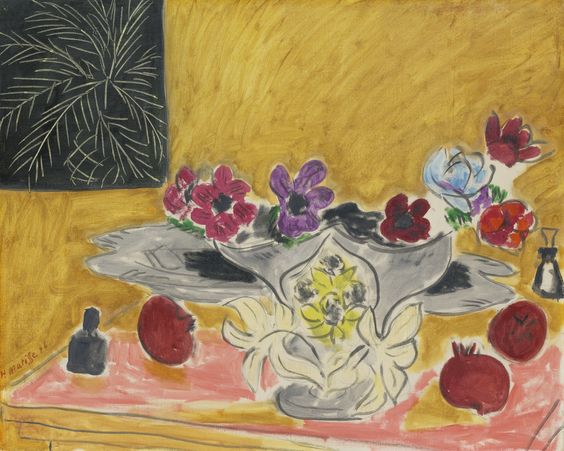Description
The work "Anemones and Pomegranates" by Henri Matisse, created in 1946, constitutes one of the most emblematic representations of the artist's prolific late period. In it, Matisse displays his mastery in the use of color and composition, distinctive traits that position him as one of the pillars of modern art. This painting, with its dimensions of 57x46 cm, offers us a poignant look at the poetic relationship between natural elements and artistic intuition.
The scene presents us with a vibrant vase of anemones next to two pomegranates, set against a predominantly blue background that evokes serenity and space. Matisse, with his characteristic style, uses color not only as a descriptive element but also as a vehicle of emotion and meaning. The imprint of his Fauvist period is unmistakable in this work, as the intense and seemingly arbitrary colors respond to a deep aesthetic reflection.
The composition of the work centers on the interplay between the exuberance of the anemones and the solidity of the pomegranates, elements deliberately arranged to combine both in form and tone. The anemones, with their open petals in loose brushstrokes, contrast with the closed, rounded shape of the pomegranates, providing a visual balance that transcends mere naturalistic representation.
One of the most notable aspects of "Anemones and Pomegranates" is the bold coexistence of primary and secondary colors, where the blue of the background and the red of the pomegranates create a harmonious link that serves as the foundation of the entire composition. The forms are delineated through color and not contour, a technique that Matisse perfected throughout his career and which is observed in this piece with clarity and skill.
Although this work does not include human figures, the way Matisse transforms everyday elements like flowers and fruits into almost personified entities speaks to his ability to capture the essence and spirit of things. In its simplicity lies a visual complexity that invites slow contemplation, revealing meanings that resonate beyond the mere pictorial surface.
It is not just a static representation, but almost an ode to vitality, where each stroke and each color seem to vibrate with their own life. This approach to the still life, imbued with vitality and an almost symbolic language, allows us to understand why Matisse is considered not only a renovator of painting but a true poet of color and form.
"Anemones and Pomegranates" can also be viewed within the broader context of his work, especially in relation to other floral pieces and still lifes such as "The Dessert" or "The Bouquet of Anemones." All of them show us a Matisse capturing the ephemeral essence of flowers, freezing the flow of time through the vibrant stillness of color.
In summary, this painting is a tangible testament to the genius of Henri Matisse, who with his unique pictorial language, knew how to transform the simple into the sublime, offering a window into a world full of serenity, color, and life. In the purity of its lines and the intensity of its shades, "Anemones and Pomegranates" continues to converse with us, reminding us of the eternal dance between nature and art.

